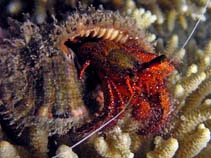Dardanus megistos (Herbst, 1804)
Whitespotted hermit| Native range | All suitable habitat | Point map | Year 2050 |

|
| This map was computer-generated and has not yet been reviewed. |
| Dardanus megistos AquaMaps Data sources: GBIF OBIS |
Classification / Names Common names | Synonyms | CoL | ITIS | WoRMS
Malacostraca | Decapoda | Diogenidae
Environment: milieu / climate zone / depth range / distribution range Ecology
Reef-associated; depth range 0 - 50 m (Ref. 96667). Tropical; 38°N - 36°S, 32°E - 134°W
Distribution Countries | FAO areas | Ecosystems | Occurrences | Introductions
Indo-Pacific: East Africa to Hawaii.
Length at first maturity / Size / Weight / Age
Maturity: Lm ? range ? - ? cm Max length : 20.0 cm TL male/unsexed; (Ref. 101422); max. reported age: 30 years (Ref. 100471)
Short description Morphology
Spermatophore has a total length of 0.0016 cm, a stalk that is 0.0090 cm long and 0.0020 cm wide and an ampulla that is 0.0060 cm long and 0.0045 cm wide (Ref. 2889).
Maximum depth from Ref. 85195. Intertidal to 50 m (Ref. 85195). Also occurs from littoral and subtidal zones (Ref. 2884); associated with coral reef, reef flats, rocky platform, rubble, sand (Ref. 81753), seagrass bed and algal mat (Ref. 106227). On coral heads in lagoons (Ref. 74671). Reported to feed on holothurians (Ref. 106232). Opportunistic omnivore (Ref. 100471).
Life cycle and mating behavior Maturity | Reproduction | Spawning | Eggs | Fecundity | Larvae
Members of the order Decapoda are mostly gonochoric. Mating behavior: Precopulatory courtship ritual is common (through olfactory and tactile cues); usually indirect sperm transfer.
Main reference
References | Coordinator | Collaborators
Barnes, D.K.A. and R.J. Arnold. 2001. (Ref. 2884)
IUCN Red List Status (Ref. 130435)
CITES status (Ref. 108899)
Not Evaluated
CMS (Ref. 116361)
Not Evaluated
Threat to humans
Human uses
Fisheries: commercial
| FishSource | Sea Around Us
Tools
More information
Internet sources
BHL | BOLD Systems | CISTI | DiscoverLife | FAO(Publication : search) | Fishipedia | GenBank (genome, nucleotide) | GloBI | Gomexsi | Google Books | Google Scholar | Google | PubMed | Tree of Life | Wikipedia (Go, Search) | Zoological Record
Estimates based on models
Preferred temperature
(Ref. 115969): 24.4 - 29, mean 28 (based on 1166 cells).
Price category
(Ref. 80766):
Unknown.
Nutrients: Calcium = 109 [35, 184] mg/100g; Iron = 1.59 [1.21, 1.97] mg/100g; Protein = 20.2 [19.2, 21.3] %; Omega3 = 0.285 [0.185, 0.386] g/100g; Selenium = 48.3 [-31.7, 128.3] μg/100g; VitaminA = 0 μg/100g; Zinc = 1.79 [1.17, 2.40] mg/100g (wet weight).



